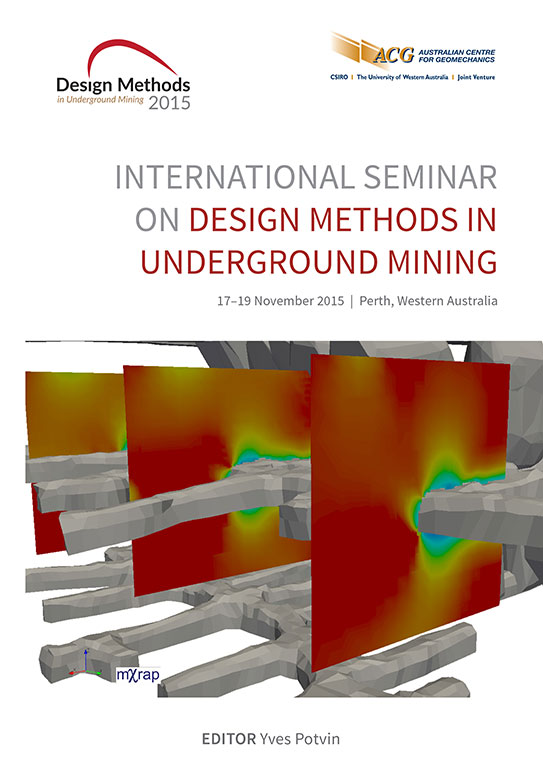Dugald River trial stoping, overall hanging wall behaviour

|
Authors: Hassell, R; de Vries, R; Player, J; Rajapakse, A |
DOI https://doi.org/10.36487/ACG_rep/1511_08_Hassell
Cite As:
Hassell, R, de Vries, R, Player, J & Rajapakse, A 2015, 'Dugald River trial stoping, overall hanging wall behaviour', in Y Potvin (ed.), Design Methods 2015: Proceedings of the International Seminar on Design Methods in Underground Mining, Australian Centre for Geomechanics, Perth, pp. 185-198, https://doi.org/10.36487/ACG_rep/1511_08_Hassell
Abstract:
Concerns regarding the uncertainty of stope dilution at MMG Limited’s Dugald River Underground Mine led to a trial stoping program to acquire full-scale comprehensive geotechnical information and to test the validity of the proposed geotechnical and mining parameters. As part of the trial, a geotechnical instrumentation program was designed to improve the understanding of the rock mass response to the mining of the trial stopes. This included an array of instruments installed from dedicated hanging wall drives, hanging walls that included 66 multipoint borehole extensometers (MPBX), 23 time domain reflectometers, 24 geophones, six accelerometers and 15 observation holes. Trial mining consisted of 19 sublevel open stopes with cemented rockfill (CRF) that extracted 335 kt of ore, with a panel height of 130 m and strike of 100 m. All stopes were monitored with a minimum of two MPBXs at the open span with a MPBX average density in the panel hanging wall of 180 m2. The MPBXs were 19 m in length and consisted of six nodes. Instrument displacement information was recorded every 30 minutes by dataloggers to a resolution of 0.12 mm. This provided a high quality, detailed and extensive rock mass response to stope extraction. The displacements were interpreted as hanging wall relaxation and shear on structure from specific stope firing and expansion of the mining front. Rock mass creep was also recorded in the hanging wall. The mechanism of displacement consisted mainly of strike-slip movement on high angle bedding and faults that are orientated sub-parallel to the dip of the orebody. Overall hanging wall behaviour was assessed by investigating the near (stope hanging wall boundary to 6 m) and far (>6 m from stope boundary) displacements as the sequence progressed. The primary rock mass response stage was the extraction of the crown pillar. The secondary responses were associated with the cable bolt arrays mitigating some of the deformation of the hanging walls with more movement mid-span compared to the cable bolt horizon. Finally, the displacement results post-filling showed the backfill mass was being slightly compacted by ground movement.
References:
Carswell, JF, Player, J, de Vries, R & Hassell, R 2015, ‘Cross-section through the trial stopes showing major fault orientations’, figure, in PM Dight (ed.), Proceedings of the Ninth International Symposium on Field Measurements in Geomechanics, Australian Centre for Geomechanics, Perth.
Hassell, R, Villaescusa, E, de Vries, R & Player, J 2015, ‘Stope blast vibration analysis at the Dugald River underground mine’, Proceedings of the 11th International Symposium on Rock Fragmentation by Blasting (Fragblast 11), The Australasian Institute of Mining and Metallurgy, Melbourne.
Hogan, P & Thompson, A 2014, Report on Intact Rock Properties Testing, report, prepared for Western Australian School of Mines, Kalgoorlie.
Mining Measurement Services Pty Ltd 2014a, MMG Limited, Dugald River Project south decline, south 220 access rock stress measurment, report, Mining Measurement Services Pty Ltd, Macclesfield.
Mining Measurement Services Pty Ltd 2014b, MMG Limited, Dugald River Project south decline, SP6 rock stress measurements, report, Mining Measurement Services Pty Ltd, Macclesfield.
MMG Limited 2014, 2014 Mineral Resources and Ore Reserves Statement, MMG Limited, Melbourne, viewed 15 June 2015,
© Copyright 2025, Australian Centre for Geomechanics (ACG), The University of Western Australia. All rights reserved.
View copyright/legal information
Please direct any queries or error reports to repository-acg@uwa.edu.au
View copyright/legal information
Please direct any queries or error reports to repository-acg@uwa.edu.au